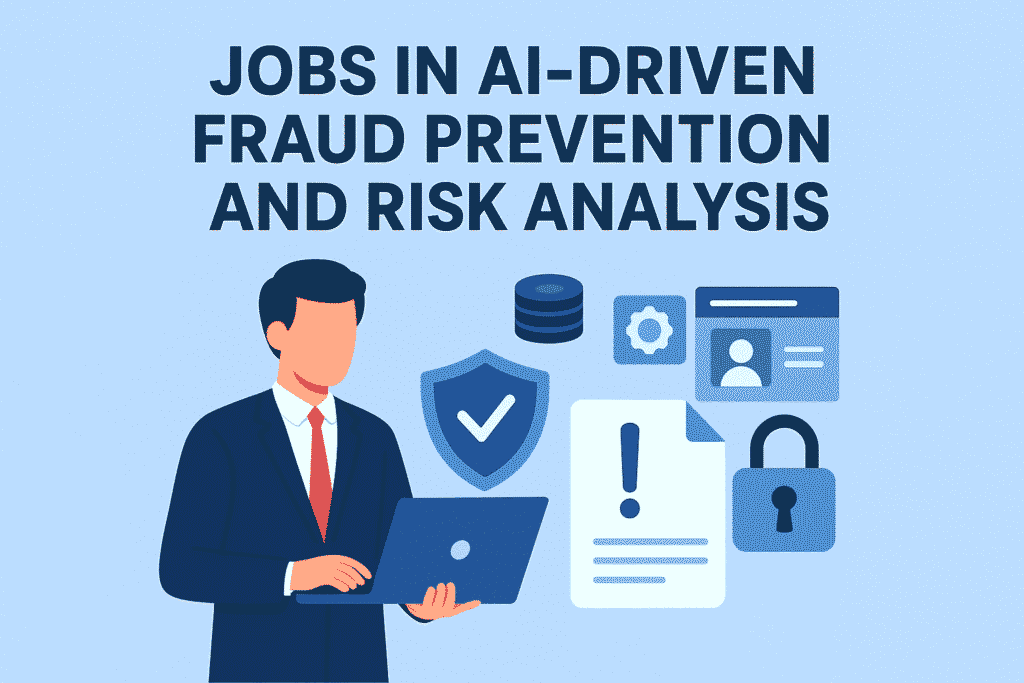Introduction: How AI Is Transforming Fraud Detection
In the digital age, data has become the new currency—and wherever there’s value, fraud soon follows. From online banking and e-commerce to cryptocurrency exchanges and insurance platforms, fraud has evolved into a sophisticated, tech-driven threat. Traditional security systems, based on static rules, simply can’t keep up with the pace and creativity of modern fraudsters.
That’s where Artificial Intelligence (AI) steps in. AI-driven fraud prevention and risk analysis systems are now the backbone of global financial safety, continuously scanning, learning, and responding to suspicious activities at lightning speed. This rapid evolution has created a massive demand for skilled professionals who can develop, deploy, and manage these AI-powered defenses.
If you’re looking to build a future-proof career that blends technology, analytics, and real-world impact, then jobs in AI-driven fraud prevention and risk analysis could be your calling.
Table of Contents
1. Understanding AI-Driven Fraud Prevention
Fraud prevention is no longer just about setting rules and monitoring transactions—it’s about building intelligent systems that can detect anomalies in real time.
1.1 The Basics of Fraud Detection
Fraud detection involves identifying suspicious behavior that indicates potential financial or data theft. Traditional systems use rule-based models, such as flagging transactions above a certain amount or unusual location. However, fraudsters quickly adapt to such fixed systems.
1.2 Why AI Makes a Difference
AI introduces adaptive learning. Machine Learning (ML) models analyze millions of transactions, detect subtle behavioral patterns, and flag potential threats before they escalate. Instead of reacting, AI systems predict and prevent fraud using:
- Supervised Learning: Trains on labeled data (e.g., legitimate vs. fraudulent transactions).
- Unsupervised Learning: Detects hidden anomalies in unlabeled datasets.
- Deep Learning: Uses neural networks to identify complex relationships in high-dimensional data.
AI systems evolve with every new fraud attempt, becoming smarter and more precise over time.

2. The Importance of Risk Analysis in Modern Businesses
Every business faces risks—financial, operational, and reputational. Risk analysis powered by AI helps organizations evaluate vulnerabilities and make data-driven decisions.
2.1 Key Functions of AI-Based Risk Analysis
- Credit Scoring: Predicting default probability based on historical and behavioral data.
- Insurance Claims Analysis: Detecting fake claims through image recognition and NLP.
- Operational Risk Assessment: Evaluating human and process-driven risks.
- Regulatory Compliance: Monitoring transactions for anti-money laundering (AML) violations.
2.2 Why Risk Analysis Is a Career Goldmine
As businesses digitize, the volume of risk-related data grows exponentially. Skilled analysts who can interpret AI insights are in huge demand—especially in banking, fintech, and cybersecurity.
3. Major Job Roles in AI-Driven Fraud Prevention
3.1 Fraud Data Analyst
- Analyzes massive transaction datasets.
- Identifies patterns and builds models to detect anomalies.
- Collaborates with AI engineers to improve algorithms.
3.2 Machine Learning Engineer
- Designs and trains models to identify fraudulent activities.
- Implements real-time detection pipelines.
- Works with cloud platforms like AWS, Azure, or GCP.
3.3 Risk Analyst (AI Focused)
- Assesses financial and operational risk exposure.
- Uses predictive analytics tools to forecast potential threats.
- Creates dashboards and reports for management.
3.4 Cybersecurity Data Scientist
- Builds AI-driven systems to detect hacking attempts.
- Integrates ML with network monitoring and identity verification.
3.5 AI Ethics and Compliance Officer
- Ensures AI fraud systems adhere to fairness and transparency standards.
- Audits algorithmic decisions to prevent bias.
4. Top Companies Hiring in AI Fraud Prevention
| Company | Specialization Area | Example Job Title | Location (Global/India) |
|---|---|---|---|
| Mastercard | Fraud risk analytics | Senior Fraud Analyst | Pune / Remote |
| PayPal | AI-based fraud detection | Machine Learning Engineer | Bangalore |
| HSBC | Risk management automation | Data Scientist – Fraud | Hyderabad |
| American Express | Transaction monitoring | Fraud Operations Manager | Gurgaon |
| Razorpay | Fintech fraud prevention | Risk Intelligence Analyst | Bangalore |
| Deloitte | AI risk consulting | Risk Modeling Specialist | Mumbai |
| Visa | Payment fraud analytics | Fraud Data Scientist | Global/Remote |
| Wells Fargo | Financial crime prevention | AI/ML Risk Analyst | Chennai |
| Amazon Pay | Transaction risk investigation | Risk Control Specialist | Hyderabad |
| JPMorgan Chase | Enterprise risk management | Fraud Strategy Analyst | Global |
These firms are expanding their AI teams rapidly, hiring talent with hybrid skills in data science, cybersecurity, and business analysis.
5. In-Demand Skills for AI Fraud Prevention Professionals
| Skill Category | Key Competencies | Average Salary (India) |
|---|---|---|
| Technical | Python, R, SQL, TensorFlow, PyTorch | ₹8–14 LPA |
| Analytical | Data mining, anomaly detection, predictive modeling | ₹6–12 LPA |
| Cybersecurity | Network monitoring, risk scoring, encryption basics | ₹7–13 LPA |
| Communication | Reporting insights, visual storytelling, client interaction | ₹5–9 LPA |
| Domain Knowledge | Banking, fintech, compliance regulations | ₹7–15 LPA |
Professionals who can blend these skills are among the highest-paid in AI-driven security roles.
6. Educational Pathways and Certifications
To enter AI fraud prevention, you don’t necessarily need a master’s degree—but strong foundational knowledge helps.
6.1 Academic Qualifications
- Bachelor’s in: Computer Science, Information Security, or Data Analytics.
- Master’s in: Artificial Intelligence, Financial Technology, or Cybersecurity.
6.2 Popular Certifications
- Certified Fraud Examiner (CFE) – Association of Certified Fraud Examiners
- Certified Information Systems Auditor (CISA) – ISACA
- IBM AI Engineering Professional Certificate – Coursera
- Google Professional Data Engineer – Google Cloud
- Microsoft Certified: Azure AI Engineer Associate
These credentials validate both AI and domain expertise, giving candidates a competitive edge.
7. Tools and Technologies Commonly Used
- Programming Languages: Python, R, and Java for model development.
- Data Platforms: Snowflake, BigQuery, Databricks.
- ML Frameworks: TensorFlow, PyTorch, Scikit-Learn.
- Visualization Tools: Power BI, Tableau.
- Automation: UiPath, Apache Airflow.
- Cloud Services: AWS SageMaker, Azure ML Studio.
Familiarity with end-to-end pipelines—from data ingestion to model deployment—is crucial for high-level roles.
8. Real-World Use Cases of AI in Fraud Prevention
8.1 Banking and Fintech
Banks like HDFC and ICICI use AI for credit card fraud detection, flagging suspicious patterns in real time.
8.2 E-Commerce
Amazon’s machine learning models detect unusual purchase behavior, reducing false positives and chargebacks.
8.3 Insurance
AI verifies claims authenticity by comparing image data, timestamps, and claimant history.
8.4 Cryptocurrency Exchanges
Exchanges like Coinbase deploy AI to identify money laundering and suspicious wallet activity.
8.5 Government & Public Sector
AI tools track tax fraud, fake identities, and benefits misuse using national data models.
9. Challenges in AI Fraud Prevention
Even with powerful technology, there are hurdles:
- Data Privacy: Balancing fraud detection with personal data protection (GDPR, DPDP Act).
- Bias in Models: AI may misinterpret minority behavior as fraud if not trained ethically.
- Adversarial Attacks: Fraudsters use AI themselves to trick detection systems.
- False Positives: Excessive alerts can disrupt legitimate user activity.
- Talent Shortage: Skilled professionals remain in short supply globally.
Addressing these issues requires both technical and ethical understanding.
10. Salary Trends and Career Growth
Entry-level analysts start with ₹5–7 LPA in India, while experienced AI fraud specialists earn ₹20–30 LPA or more. Globally, salaries range from $90,000 to $160,000 annually for senior engineers.
Career Growth Path:
- Junior Analyst → Senior Fraud Analyst → AI Model Developer → Risk Manager → Head of AI Fraud Analytics
Professionals with combined expertise in AI and finance can transition into Chief Risk Officer (CRO) roles in the long term.
11. Future Outlook of AI-Driven Fraud Prevention
AI in fraud prevention is projected to grow from $20 billion (2024) to $65 billion by 2030, according to industry forecasts.
Emerging areas include:
- Generative AI for Threat Simulation
- Explainable AI (XAI) for transparency in fraud decisions
- Blockchain-AI Integration for secure data validation
- Edge AI for real-time, low-latency fraud detection in IoT systems
These trends will redefine the future of digital trust and cybersecurity.

12. How to Start Your Career in AI Fraud Prevention
Step 1: Learn Python and Data Analysis.
Step 2: Master machine learning algorithms (especially anomaly detection).
Step 3: Gain domain knowledge in finance, payments, or insurance.
Step 4: Complete a project—build a small fraud detection model using public datasets (like Kaggle’s credit card fraud dataset).
Step 5: Apply for internships or freelance projects on platforms like Upwork or Turing.
Step 6: Network with professionals on LinkedIn and attend fintech-AI webinars.
13. Ethical Dimensions and AI Governance
AI systems must balance efficiency with fairness. Ethical fraud detection ensures:
- Transparent decision-making processes.
- Avoidance of profiling based on geography or behavior.
- Human oversight for disputed transactions.
Governments and organizations are setting AI ethics standards, making AI governance a parallel career path within fraud prevention.
14. The Broader Impact of AI on Society
AI-driven fraud prevention not only secures financial systems but also builds digital trust, encouraging innovation in fintech, e-commerce, and health data sharing.
As automation spreads, trust and transparency become as valuable as profits—making AI fraud specialists guardians of modern digital civilization.
15. Top Learning Paths and Courses to Build Your AI Fraud Prevention Career
Building a strong foundation in AI and risk analytics doesn’t always require a traditional master’s degree. Today, a combination of online certifications, practical projects, and self-paced learning can help you gain the same expertise at a fraction of the cost.
Let’s explore the most recommended learning paths, trusted by industry professionals.
15.1 Foundational Courses
If you’re starting fresh, begin with the basics of data science and machine learning before diving into fraud prevention.
- Coursera – “Machine Learning” by Andrew Ng
- Platform: Coursera
- Duration: 11 weeks
- Teaches the fundamentals of supervised and unsupervised learning, linear regression, logistic regression, and clustering.
- edX – “Data Science Essentials” by Microsoft
- Platform: edX
- Focuses on statistics, data exploration, and visualization.
- Udemy – “Python for Data Science and Machine Learning Bootcamp”
- Platform: Udemy
- Covers NumPy, pandas, Matplotlib, and Scikit-learn — essential tools for fraud analytics.
15.2 Specialized Fraud Detection Courses
Once you understand the fundamentals, shift toward niche areas like financial data modeling and fraud risk management.
- Coursera – “AI in Financial Services” by University of Michigan
- Covers AI applications in banking, fraud prevention, and compliance.
- Udemy – “Credit Card Fraud Detection Using Machine Learning in Python”
- A project-based course where you build a fraud detection model using real-world datasets.
- LinkedIn Learning – “Financial Crime Prevention”
- Teaches AML compliance, transaction monitoring, and fraud prevention strategies.
15.3 Advanced & Career-Oriented Certifications
- Certified Fraud Examiner (CFE) – Ideal for professionals aspiring to join global fraud investigation roles.
- Google Cloud Professional Data Engineer – For those building scalable AI models in production.
- IBM AI Engineering Professional Certificate – Covers end-to-end AI lifecycle, including model deployment.
- NASSCOM Certified AI Analyst (India-specific) – Validates AI domain expertise for Indian markets.
15.4 Continuous Learning
Since AI technologies evolve rapidly, professionals must constantly upskill through webinars, hackathons, and community projects on platforms like Kaggle, Zindi, and GitHub.
16. Real-World Case Studies: How Leading Companies Use AI for Fraud Detection
Let’s explore how global leaders are implementing AI-driven fraud systems to enhance security and reduce financial losses.
16.1 PayPal – Real-Time AI Transaction Monitoring
PayPal’s AI model analyzes over 1,000 parameters for every transaction in milliseconds, identifying suspicious behavior before approval.
Their system uses ensemble learning models that cross-check location, device ID, purchase pattern, and behavioral fingerprinting.
Results:
- 75% reduction in false positives
- $44 million saved in a single fiscal year
16.2 Mastercard – Decision Intelligence
Mastercard integrates deep learning and graph analytics to detect fraudulent relationships between merchants and users.
Their model learns from billions of transactions daily, improving risk scoring accuracy.
Results:
- Detected 60% more complex fraud cases than traditional systems
- Enabled near real-time fraud scoring for banks globally
16.3 Razorpay – Fintech Fraud Analytics
India’s Razorpay uses AI to identify transaction spikes, fake accounts, and synthetic identity fraud.
Their “Risk 2.0” platform combines rule-based engines with neural networks for smarter verification.
Results:
- Reduced fraud-related chargebacks by 35%
- Enhanced KYC verification process with machine learning models
16.4 Amazon – Behavioral Pattern Recognition
Amazon monitors billions of activities daily using AI. Their systems detect fake reviews, counterfeit sellers, and unusual purchasing trends.
Results:
- Over 700,000 fake accounts blocked annually
- Fraudulent listings reduced by 99%
These success stories show how AI not only protects businesses but also ensures trust among consumers, making fraud prevention a key differentiator in the global economy.
17. Building an AI Fraud Detection Model (Step-by-Step Guide)
Want to understand what these systems look like in practice? Let’s walk through a simplified roadmap for building your own AI-powered fraud detection model.
Step 1: Data Collection
Gather transactional datasets from trusted sources like Kaggle’s Credit Card Fraud Detection dataset. Ensure data includes features like transaction amount, location, device type, and time.
Step 2: Data Preprocessing
- Handle missing values.
- Normalize numerical data.
- Convert categorical variables using OneHotEncoding.
Step 3: Exploratory Data Analysis
Visualize fraudulent vs. non-fraudulent transaction patterns using Matplotlib or Seaborn.
Identify skewed data distributions and anomalies.
Step 4: Model Selection
Use algorithms like:
- Logistic Regression for interpretability.
- Random Forest / XGBoost for performance.
- Autoencoders or LSTM for advanced anomaly detection.
Step 5: Training and Evaluation
Split the dataset (e.g., 80% training, 20% testing).
Use Precision, Recall, and AUC metrics — accuracy alone isn’t enough because fraud cases are rare.
Step 6: Real-Time Implementation
Deploy your model using Flask (Python) and connect it to APIs or payment systems for real-time predictions.
Step 7: Continuous Learning
Feed new transaction data back into the model regularly to adapt to emerging fraud trends.
This hands-on process gives you real project experience, which employers highly value.
18. Global vs. Indian Market Demand and Salary Comparison
AI-driven fraud prevention is among the fastest-growing tech segments worldwide, but the opportunities differ across geographies.
| Region | Average Annual Salary (USD) | Job Availability (2025) | Top Hiring Sectors |
|---|---|---|---|
| United States | $110,000 – $160,000 | Very High | Banking, Fintech, E-commerce |
| Europe | $90,000 – $130,000 | High | Insurance, Retail, Telecom |
| India | $15,000 – $40,000 (₹12–30 LPA) | Very High | Fintech, Payments, IT Services |
| Middle East | $40,000 – $70,000 | Medium | Government, Cybersecurity |
| Southeast Asia | $25,000 – $60,000 | High | E-commerce, Startups |
18.1 Market Growth Insights
According to Deloitte and PwC reports:
- The global AI in fraud management market will exceed $65 billion by 2030.
- India’s fintech fraud detection sector is growing at 35% annually, driven by UPI and digital wallet transactions.
These trends underline how AI expertise in fraud detection will remain in high demand across every continent.

19. Comparison of Popular AI Tools for Fraud Detection
| Tool / Platform | Core Functionality | Strengths | Best For |
|---|---|---|---|
| Feedzai | Real-time transaction monitoring | Excellent scalability, used by banks | Enterprise systems |
| SAS Fraud Management | Predictive analytics | Integrated visualization & AML support | Financial institutions |
| DataVisor | Unsupervised ML fraud detection | Detects new fraud patterns without labels | E-commerce & social media |
| Kount (Equifax) | AI-driven digital identity protection | Great for payment fraud & account takeover prevention | Fintech & retail |
| Actimize (NICE) | Financial crime analytics | Covers AML, compliance, and risk scoring | Large enterprises |
| AWS Fraud Detector | Custom fraud models via AWS | Easy integration for developers | Startups, small businesses |
Each platform uses unique AI approaches—some emphasize graph-based models, while others focus on unsupervised clustering, depending on the business context.
20. Future Career Opportunities in AI Fraud Analytics
The next decade will bring a wave of new hybrid job roles that merge data science, ethics, and law.
20.1 Emerging Roles
- AI Risk Governance Specialist – Ensures AI fairness and compliance.
- Fraud Data Engineer – Builds data pipelines for model training.
- Behavioral Analytics Researcher – Studies customer behavior for anomaly detection.
- Fraud Detection Product Manager – Bridges the gap between AI developers and compliance teams.
- Generative AI Fraud Analyst – Uses AI to simulate and defend against AI-generated fraud attacks.
20.2 Remote and Freelance Jobs
Companies like Telus International, Welocalize, and Remotasks offer remote work in data annotation, AI risk modeling, and fraud data labeling — ideal for entry-level professionals.
21. Ethical, Legal, and Societal Implications
As AI’s reach expands, the ethical responsibility on fraud prevention professionals also intensifies.
21.1 Key Ethical Principles
- Transparency: Users deserve to know when AI makes financial decisions about them.
- Fairness: AI systems must not unfairly penalize users based on geography or spending patterns.
- Accountability: Businesses must audit algorithms regularly.
- Data Privacy: Compliance with GDPR and India’s DPDP Act ensures ethical data handling.
21.2 Legal Regulations
- EU AI Act (2024): Regulates high-risk AI systems, including fraud detection.
- RBI Guidelines: Mandate fraud reporting and secure transaction monitoring in India.
- FATF Standards: Set global anti-money laundering protocols.
Ethical governance ensures AI fraud prevention remains a force for good, not a source of bias.
22. The Road Ahead: Predictions for the Next Decade
Experts forecast an AI-powered security renaissance by 2035, where predictive and adaptive fraud systems will dominate digital ecosystems.
Here’s what’s on the horizon:
- Self-healing AI models that adapt instantly to new fraud techniques.
- Quantum computing integration to enhance encryption and pattern recognition.
- Voiceprint and emotion-based fraud detection using multimodal AI.
- Unified fraud detection networks across banks for shared intelligence.
By 2030, AI will be the default layer of defense in all major financial systems.
Global Case Studies of AI in Fraud Prevention
1. PayPal – Real-Time Machine Learning in Transaction Security
PayPal, a global payments leader, processes millions of transactions daily across borders. Traditional rule-based fraud detection systems struggled to keep up with evolving scams. To counter this, PayPal integrated AI-driven risk modeling using neural networks that analyze historical and real-time transaction data simultaneously.
The system continuously learns from new fraud patterns, customer behaviors, and contextual signals such as device type, transaction velocity, and location anomalies. This has reduced fraud loss by nearly 50% while minimizing false positives that block legitimate transactions.
Moreover, PayPal uses behavioral biometrics — tracking how a user types, moves a mouse, or interacts with their app — to identify suspicious activity patterns. This human-AI combination gives them a predictive edge in identifying synthetic identities before the damage occurs.
2. Mastercard’s Decision Intelligence System
Mastercard’s Decision Intelligence (DI) tool is another pioneering case of AI-driven fraud prevention. It uses deep learning models that assess over 200 data elements per transaction — from spending behavior to merchant history. DI doesn’t just detect fraud; it predicts the likelihood of a transaction being genuine or fraudulent.
This intelligent system is embedded into Mastercard’s global payment network, allowing real-time decision-making without disrupting the user experience. The result? Fewer transaction declines for legitimate users and a significant decrease in fraudulent chargebacks.
3. Razorpay and Indian FinTech AI Adoption
India’s booming fintech ecosystem has also embraced AI in risk analysis. Companies like Razorpay and PhonePe employ machine learning algorithms to spot abnormal transaction volumes, location mismatches, and bot-driven payment attempts.
Razorpay’s “Thirdwatch”, an AI-powered risk engine, uses over 2000 parameters — including device fingerprinting, geolocation, and behavioral profiling — to automatically block or flag suspicious orders. Since implementing AI, Razorpay has seen a 70% reduction in manual review time.
Advanced AI Tools Used in Fraud Detection and Risk Analysis
The AI fraud prevention space is rich with specialized tools and frameworks that help organizations stay ahead of cybercriminals. Below is a comprehensive table of popular platforms and their unique capabilities.
Table 1: Leading AI Tools for Fraud Detection and Risk Analysis
| Tool Name | Key Features | Used By | Pricing / Model |
|---|---|---|---|
| DataVisor | Unsupervised ML for mass fraud detection, scalable to billions of events | Alibaba, Pinterest | Custom Enterprise |
| Feedzai | Real-time risk management for banking and payments | Citi, HSBC | SaaS Subscription |
| Kount | AI-based identity trust and fraud prevention for e-commerce | Chase, US Bank | Tier-based Pricing |
| Darktrace | Self-learning AI for insider threat and fraud | Barclays, Telefónica | Enterprise License |
| Amazon Fraud Detector | Managed service to identify fraudulent activities using AWS ML | Amazon, Startups | Pay-as-you-go |
| SAS Fraud Management | Combines analytics, ML, and visualization for financial fraud | Banks, Insurance | Enterprise |
| FICO Falcon | Predictive analytics platform for card fraud detection | Visa, Mastercard | Subscription |
| ComplyAdvantage | AI-driven AML and transaction monitoring | Fintechs, Banks | API-based Plans |
These platforms combine data mining, neural networks, predictive modeling, and natural language processing to detect anomalies that human analysts would miss.
Building an AI-Powered Fraud Detection Model (Step-by-Step)
Creating your own fraud detection system using AI requires a structured approach. Below is a simplified blueprint followed by fintech companies and cybersecurity startups.
Step 1: Data Collection
Gather large-scale datasets including transaction logs, user profiles, device fingerprints, and known fraud instances. Ensure privacy compliance (GDPR, RBI, PCI-DSS).
Step 2: Data Cleaning and Feature Engineering
Eliminate duplicate or incomplete entries. Then, build features like transaction frequency, login time variance, device ID changes, and spending deviations.
Step 3: Model Selection
Choose algorithms like:
- Logistic Regression (for baseline probability)
- Random Forest (for interpretability)
- Gradient Boosted Trees (XGBoost, LightGBM) (for accuracy)
- Neural Networks (for large data complexity)
Step 4: Model Training and Validation
Split your data into training (70%) and testing (30%) sets. Use cross-validation and confusion matrices to balance false positives vs false negatives.
Step 5: Real-Time Deployment
Deploy your model via APIs that integrate with your transaction systems. Automate alerts for risky behaviors and enable feedback loops for self-learning.
Step 6: Continuous Learning
Fraudsters evolve fast. So should your model. Use active learning and online training to make your AI smarter with every transaction.

Career Growth Opportunities in AI Fraud Prevention
The demand for fraud prevention professionals is growing across industries — from fintech to telecom, e-commerce, insurance, and even the public sector.
High-Demand Job Roles
| Job Title | Average Salary (India) | Average Salary (Global) | Key Skills Required |
|---|---|---|---|
| Fraud Data Analyst | ₹7–12 LPA | $70K–100K | SQL, Python, Data Analysis |
| Machine Learning Engineer (Fraud AI) | ₹12–25 LPA | $100K–140K | ML, TensorFlow, Anomaly Detection |
| Risk Intelligence Specialist | ₹8–15 LPA | $90K–120K | Risk Modeling, Compliance |
| Cybersecurity Analyst | ₹6–10 LPA | $80K–110K | SIEM, IDS/IPS, Threat Analysis |
| Fraud Investigation Manager | ₹10–18 LPA | $110K–150K | AML, Financial Forensics |
These positions are not only high-paying but also remote-friendly, especially in global fintech firms and compliance consultancies.
The Rise of No-Interview Remote Jobs in Fraud Analysis
An emerging trend in 2025 is the growth of no-interview, task-based remote jobs in fraud prevention. Companies like Welocalize, Telus International, and Appen are expanding into AI risk data labeling, where employees analyze datasets related to fraudulent transactions or risky behaviors.
These roles typically involve:
- Labeling fraudulent vs legitimate data points
- Annotating transaction text or behavior logs
- Quality checking AI model predictions
They pay per task or hour (₹600–₹1500/hour), require no interviews, and are ideal for freshers or remote workers looking to enter the AI fraud domain.
Future of AI in Fraud Detection (2025–2035)
Over the next decade, fraud detection will shift from reactive detection to predictive prevention. Here are the key trends shaping the future:
- Quantum-Resistant AI Security Models – Protecting financial systems against post-quantum threats.
- Federated Learning for Data Privacy – Allowing banks to train AI models collaboratively without sharing sensitive data.
- Explainable AI (XAI) – Ensuring AI fraud systems remain transparent and legally compliant.
- Multi-Agent AI Systems – Using swarms of AI models that interact and vote on transaction legitimacy.
- Blockchain Integration – Combining decentralized ledgers with AI verification for ultimate trust.
- Voice and Emotion Recognition in KYC – Detecting fraudulent intent through tone, stress, and micro-expressions.
Global Impact and Ethical Considerations
AI-driven fraud prevention extends beyond finance. Governments are deploying similar systems to combat tax evasion, welfare fraud, and cybercrimes. However, ethical concerns arise — especially around bias and false accusations. A biased model could mistakenly flag legitimate users based on skewed data.
Therefore, companies must:
- Regularly audit AI models for bias.
- Include human review layers.
- Maintain transparency in AI-driven decisions.
AI should not just prevent fraud — it must preserve fairness, privacy, and trust.
Conclusion: Your Pathway to a Rewarding Future
A career in AI-driven fraud prevention and risk analysis combines analytical intelligence, ethical judgment, and technological mastery. Professionals in this field don’t just analyze data—they protect global economies, uphold digital trust, and shape the future of financial security.
If you have the curiosity to detect patterns, the discipline to learn continuously, and the drive to make an impact, then this field is your gateway to a truly future-proof, meaningful, and well-paying career.
The world’s financial ecosystem depends on AI experts like you to keep it safe.
follow us on whatsapp channel

















